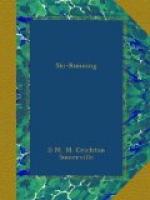Part (b).—A descent of not less than 1,000 feet on hard snow, such as unbreakable crust or snow which has been thoroughly beaten down.
Part (c).—A descent of at least 500 feet of woodrunning, dense enough to prevent straight running, but not too dense to prevent continuous turns.
1. A Second Class runner may be defined as a runner who can run at a good speed on hard or soft snow of unvarying quality, and who is, above all, thoroughly steady on his turns. A runner who runs recklessly without judgment, and who shows little power of selecting a safe line, should not be passed even if he takes slopes straight at the expense of frequent falls. The Second Class Test is, in the main, a test of steady controlled ski-ing at a good, but not at a racing speed.
2. Candidates must not use their sticks to control speed nor to help out a turn except under very exceptional circumstances and with the express permission of the Judges. The Judges must, however, satisfy themselves that the Candidates understand the use of the stick, and could, in emergencies, where speed is vital, increase their speed and steadiness on difficult snow by the use of the stick.
QUALIFYING TEST FOR THE FIRST CLASS (CROSS COUNTRY).
No candidate may enter for Parts (a), (b) and (c) of the First Class Test until he has passed the Qualifying Test that entitles him to be judged for the First Class Test, and no candidate may enter for this Qualifying Test until he has passed the Second Class Test.
The Qualifying Test consists of five parts, which may be judged on different days and before different Judges, but which must all be passed in the same season.
Part (a).—Four continuous lifted Stemming turns on a slope of hard snow at an angle of not less than 30 degrees.
Part (b).—Four continuous Telemark turns on a slope of soft snow at an angle of not less than 30.
Part (c).—Four consecutive jump-turns to connect downhill tacks on a slope of breakable crust at an angle of about 30 degrees.
Part (d).—Christiania swings to a standstill (right and left) from a direct descent at a very high speed.
Part (e).—Four continuous Christiania (see General Instructions) on a slope of about 20 degrees.
INSTRUCTIONS TO JUDGES.
1. The turns must be done round sticks or flags placed by the Judges.
2. Not more than three attempts at any one part are allowed on the same day.
3. Soft breakable crust will usually be found on slopes with a southerly exposure just after the sun has struck them or just before the sun leaves them.
FIRST CLASS TEST (CROSS COUNTRY SKI-ING).
The First Class Test consists of three parts, which must all be passed in the same season and should, if possible, be passed by the same Judges. If this is impracticable, Judges must indicate on the Test forms which parts they have judged. Not more than two parts shall be judged on the same day.




